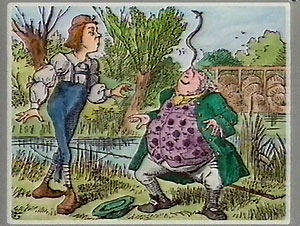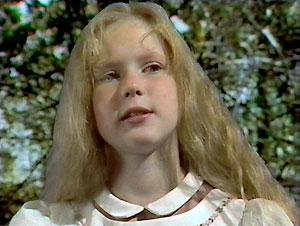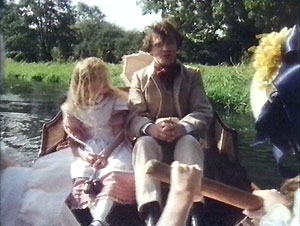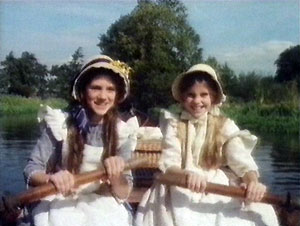| |
There's very little information about the
1985 Anglia Television adaptation of Lewis Carroll's masterpiece
Alice in Wonderland on the Internet, but that's not altogether
surprising. It was almost immediately overshadowed by the much more
lavish 1986 version (directed by Barry Letts, and produced by Terrance
Dicks, both veterans of the Jon Pertwee era of Doctor Who), which
aired in BBC1's prestigious 'Sunday Classics' slot. Anglia's version,
which aired on Tuesday afternoons, was quickly forgotten: as far as I
know it has never been repeated, and it has never been released on any
home video format.
Anglia Television don't have much of a
reputation for making drama series, and certainly never came close to
rivalling other regions like ATV, Thames and Granada in terms of output.
In fact Anglia's enduring drama legacy amounts to a handful of series:
most notably the sting-in-the-tail anthology series Tales of the
Unexpected (1979-88) and a brace of adaptations of P.D.James crime
novels (Death of an Expert Witness (1983), Shroud for a
Nightingale (1984), etc). That's not much to show for a franchise
that's been running since 1959!
According to the end credits, the Anglia
series was inspired and based upon an early production put on by the
famous Da Silva Puppets group at the Norwich Puppet Theatre (which was
founded in 1979). The company regularly performed - and, indeed,
continues to perform - shows based on classic children's literature,
such as Treasure Island and Pinocchio.
The series was produced and directed by
Harry Aldous, an industry veteran who had worked as a film editor on
several Ealing Studios classics, including perennial favourites
Passport to Pimlico, The Ladykillers and The Lavender Hill
Mob. It must have been a dauntingly ambitious production, requiring
the use of many elaborate technical techniques, including extensive use
of TV's equivalent of "green screen", CSO (colour separation overlay).
Most of the series is a blend of puppetry (a mixture of marionettes and
rod puppets) and a live action element (in the form of Alice), set
against photographic or live action backgrounds. Almost all of the
creatures Alice encounters are puppets, with, it seems, the exception of
the mouse in the Pool of Tears sequence, which was played by someone in
a costume (perhaps it was the only outfit the production could get from
stock?)
The script adheres quite closely to
Carroll's story, and features most of the book's key characters and
set-pieces (unlike many other film and TV versions, which frequently
borrow from Carroll's 1871 sequel Through The Looking-Glass, and What
Alice Found There). In fact, the adaptation is so close that there
is no "adapted by" credit, or even one for a script editor, indicating
that Aldous was responsible for this aspect of the production, too.
In what has become something of a
customary addition, Anglia's adaptation begins with a 'real-life'
sequence depicting the Reverend Dodgson (a.k.a. Lewis Carroll) telling
the story to the three Liddell sisters, during an 1862 rowing boat trip
on the Thames. The Anglia adaptation is also book-ended with the novel's
'real-life' scenes of Alice playing with her sister on the river bank.
Incidentally, it's probably safe to assume that the 'Kesser Andrews' who
plays one of Alice's sisters in these sequences is the real-life sibling
of Alice actress Giselle Andrews.
 The
look of the series is also faithfully modelled on the book, in that it
closely mimics John Tenniel's iconic book illustrations (which date back
to the first published edition of Carroll's novel, in 1865). Several of
Tenniel's illustrations are recreated quite precisely, although some
have been re-staged back-to-front, in common with some less-faithful
editions of the book. A few of Tenniel's illustrations even appear
on-screen, such as the coloured illustrations for You are old, Father
William, as re-told by the Caterpillar (left - tellingly, this is
another 'flopped' image). The
look of the series is also faithfully modelled on the book, in that it
closely mimics John Tenniel's iconic book illustrations (which date back
to the first published edition of Carroll's novel, in 1865). Several of
Tenniel's illustrations are recreated quite precisely, although some
have been re-staged back-to-front, in common with some less-faithful
editions of the book. A few of Tenniel's illustrations even appear
on-screen, such as the coloured illustrations for You are old, Father
William, as re-told by the Caterpillar (left - tellingly, this is
another 'flopped' image).
The series' designer was Spencer Chapman,
who also worked on Anglia's Tales of the Unexpected. Chapman has
an impressive resume of BBC prodictions, including the 1964 Doctor
Who story The Dalek Invasion of Earth; Dennis Potter's
highly-controversial Wednesday Play, Son of Man (1969);
and prestigious BBC drama series The Forsyte Saga (1967).
Coincidentally, Potter was also bewitched by Carroll's stories: he
blended the books with a biography of Dodgson for the BBC in 1964, as
another Wednesday Play, simply titled Alice, and re-worked
the story into the sorely neglected 1985 Thorn EMI film Dreamchild,
which boasted stunning Wonderland creatures from the Jim Henson
organisation.
The Anglia production generally uses sets
for the interior scenes (the room of doors, Rabbit's house, the
courtroom, etc), and photographic backgrounds for the exterior scenes
(including all the interstitial woodland scenes, the beach, and the
croquet court, etc). Most of the show was recorded on videotape (a
necessity, given the effects work required), with the live-action
sequences dropped in from film inserts.
Giselle Andrews,
who played Alice, was a thirteen year-old pupil at Yarmouth High School,
Norfolk, when the series was made. Usually the part is played by an older actress;
almost always one who is older than ten, which was the real Alice Liddell's
age when Carroll narrated his tale. The role is a demanding one, not
suited to a young child. Some adaptations have opted for
performers in their teens (thirteen year-old Tina Majorino in Hallmark's
1999 adaptation, or sixteen year-old Fiona Fullerton in the 1972 film,
for example), others for even older actresses (Charlotte Henry was
twenty when she made Paramount's star-studded 1933 film, and Carol Marsh
was a whopping twenty-three when she starred in Lou Bunin's
largely-suppressed 1949 version). Andrews, at the younger end
of the age scale, rivals the ten year-old Natalie
Gregory in Irwin Allen's glitzy 1985 TV version. The Internet Movie
Database (IMDb) - which, admittedly, does not cover television at all
comprehensively - has Alice in
Wonderland her sole credit, suggesting that her acting
career was not a lengthy one. Similarly, none of the "Robert Peters"
(who played the Reverend Dodgson) listed by the IMDb seems to be the one
who appeared here.
A record of this version of Alice in Wonderland
has only recently been added to the IMDb (since this article was
originally published, in fact), so it may have come as a
surprise to some people to discover that the series featured a number of
notable performers giving voice to the various people and creatures
Alice encounters. Many are instantly recognisable, because they're
performers whose careers have continued to flourish, or people who have
been immortalised at their peak by a particular role that still
resonates. Almost all are very well-cast, especially the Jackanory-honed
tones of Bernard Cribbins, who plays the mournful Mock Turtle, and
master of the funny voice Michael Bentine, who plays the March Hare.
Other perfectly cast voices include regular sitcom battleaxe Joan
Sanderson as the Queen of Hearts, and John Barron, perhaps best known as
C.J. in The Fall and Rise of Reginald Perrin, as the lugubrious
Caterpillar.
Almost all of the featured characters
have well-known performers giving them their voice, with veteran voice
artistes Jon Glover and Mary Miller filling in the supporting roles.
Music for the production was provided by
Peter Fenn, who became something of a household name, for his work as
organist on Anglia's enormously popular "Quiz of the Week", Sale of
the Century (1971-1985).
It's fair to say that the production is
hamstrung both by its budget, and by the technology of the time (it was
made a few years after ground-breaking digital image manipulation
devices like those from Quantel were available, but before they were
widely adopted within the industry). Much of the series struggles to
rise above the production values you'd expect from a (typically under
funded) children's television series of the time. The puppets, which
were perhaps the ones made for the theatrical production, are crude, and
not well-suited to the intense scrutiny of the television close-up. Even
the puppets who are given a lot of screen time, like the Mock Turtle and
Mad Hatter, have very little articulation, and are barely capable of
much more than opening and closing their mouths.
The cast and crew of Anglia's Alice in
Wonderland attempted a very ambitious project, and probably did so
with a fraction of the funds given to other TV adaptations. It's a
rather clunky re-telling of the story, but one that's not without charm
and invention.
As a footnote, it's perhaps worth noting
that, a couple of years after making Alice in Wonderland, Anglia
produced the long-running kids' adventure / quiz show Knightmare,
which began its run in 1987. The series used many of the same special
effects techniques used in their production of Alice in Wonderland,
using CSO (or a slightly more sophisticated version of the technique) to
place its young contestants in computer-generated sets, so perhaps the
experience stood them in good stead.
In the spirit of full disclosure, I
should mention that I've recently only seen four of the five episodes.
The series was broadcast in five
twenty-minute episodes:
Episode One - Down The Rabbit Hole and
The Pool of Tears (TX: 26/3/85)
Episode Two - A Long Tail, A Little
Bill and Advice From A Caterpillar (TX: 2/4/85)
Episode Three - Pig and Pepper and
Onto a Tea Party (TX: 9/4/85)
Episode Four - A Mad Hatter's Tea
Party and The Queen's Croquet Ground (TX: 16/4/85)
Episode Five- The Mock Turtle's Story,
The Lobster Quadrille and Who Stole The Tarts? (TX:
23/4/85)
|
 |
CAST:
Alice - Giselle Andrews
The Reverend Charles Dodgson - Robert
Peters
Alice's Sisters - Kesser Andrews,
Kate Tooley
VOICES:
White Rabbit - Paul Eddington
Lory, Dodo - John Braban
The Caterpillar - John Barron
Mad Hatter - Eric Sykes
March Hare - Michael Bentine
The Cheshire Cat - Leslie Crowther
The Duchess - Eleanor Bron
Mock Turtle - Bernard Cribbins
Gryphon - Windsor Davies
Doormouse [sic] - Royce Mills
The Queen of Hearts - Joan Sanderson
The King of Hearts - Leonard Rossiter
Pat, Mrs Pat, Bill, Knave, Fish
Footman, Frog Footman - Jon Glover
Mouse, Duck, Parrot, Longbeaked Bird,
Pigeon, Cook, Baby - Mary Miller
CREW:
Director of Puppetry - Stephen
Mottram
Puppeteers - Kim Bergsagel, Ray Da
Silva, Joan Da Silva, Joe Fane-Gladwin, Richard Marriott, Peter
O'Rourke, Gillie Robic
Based on the production by Dasilva
Puppets at Norwich Puppet Theatre [sic]
Dubbing Mixer - Terence Barker
Dubbing Editor - Patrick Foster
Videotape Editor - Giles Tuffield
Music - Peter Fenn
Lighting Directors - Chris Brown,
Malcolm Harrison, Roger Law
Designer - Spencer Chapman
Produced and Directed by Harry Aldous
© Anglia Television Limited MCMLXXXV |
| |
|
 |
| |
|
 |
|
|